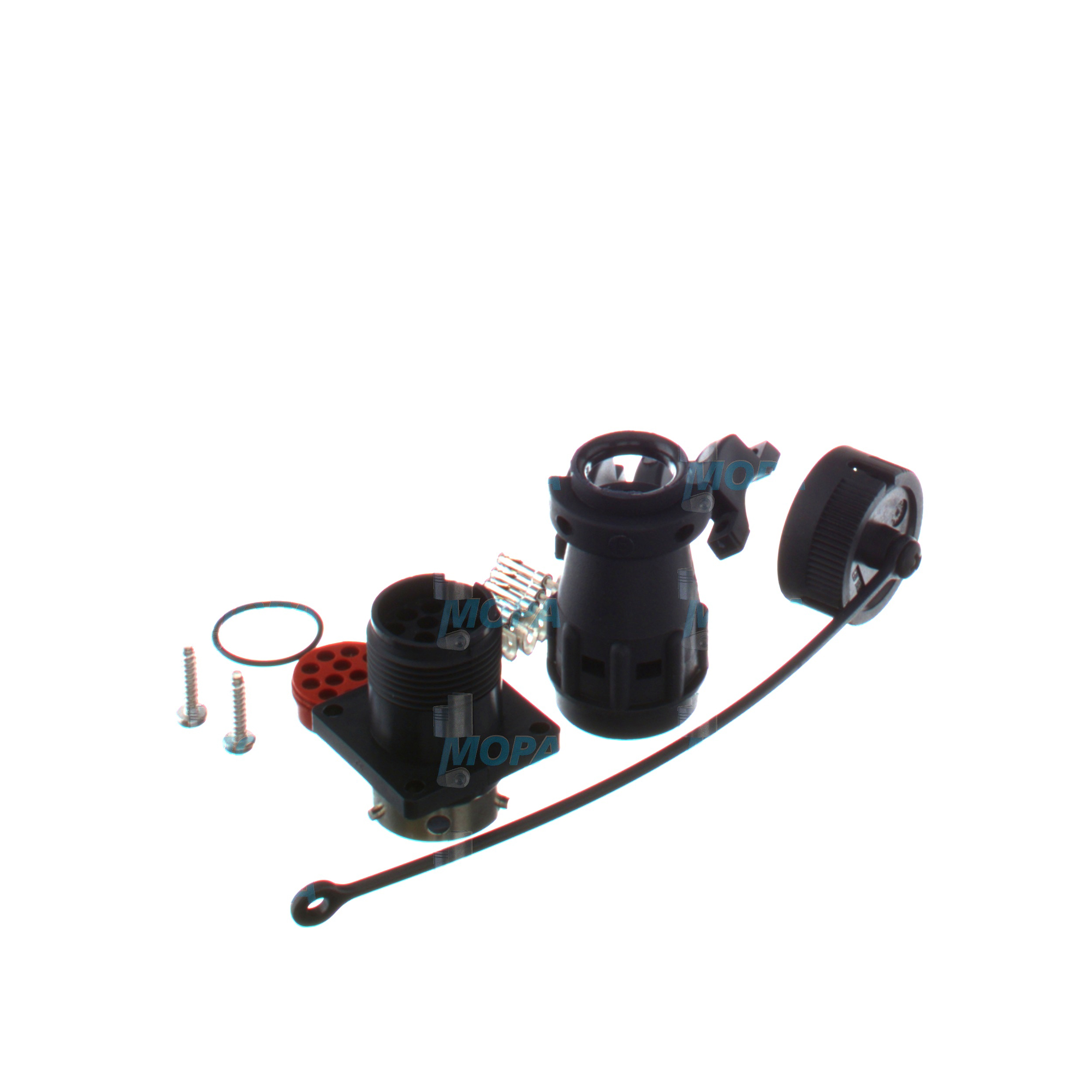PLUG-IN CONNECTOR Electric Components and Switches for Diesel and Gas Engines
Electric components and switches are the nervous system of modern diesel and gas engines. This article category covers the full spectrum of control, measurement, and power distribution hardware: sensors, relays, contactors, ignition modules, engine safety switches, terminal blocks, and every PLUG-IN CONNECTOR that ties the harness to the engine control unit (ECU) and auxiliaries. In marine engine rooms, propulsion packs, and power-generation sets, these components determine how reliably the engine starts, how precisely it burns fuel, and how safely it shuts down under fault conditions.
Beyond basic on/off functionality, electric components and switches transform real operating conditions into actionable control signals. Temperature, pressure, speed, and vibration are captured by transducers, routed through sealed connectors, and interpreted by the ECU to optimize injection timing, air–fuel ratios, and protection thresholds. When a failure occurs—overheat, low oil pressure, overspeed—switches and relays execute immediate, controlled responses. That is why robust design, correct ratings, and exact connector interfaces matter as much as the mechanical hardware of the engine itself.
PLUG-IN CONNECTOR Interfaces in Electric Components and Switches: Technical Function
In an engine, electric components and switches fulfill three core functions: precise sensing, dependable actuation, and clean signal/power distribution. The PLUG-IN CONNECTOR marine engine interface sits at the center of all three. It provides a sealed, vibration-resistant pathway for sensor outputs (4–20 mA, 0–10 V, PWM), ignition triggers on gas engines, and high-current feeds to starters, heaters, or fuel shut-off solenoids. Correct mating geometry, pin plating, and retention force prevent intermittent contacts that can corrupt ECU data or trip safety circuits.
On a diesel engine, switching devices such as relays and contactors manage starter currents and preheating systems, while limit switches and E-stops define safety loops. Speed pickups, boost pressure transmitters, and coolant temperature sensors convert analog conditions into stable signals. The PLUG-IN CONNECTOR diesel engine harness ensures each device connects with the right pinout, shielding, and IP-rated sealing so that EMC noise, salt mist, and oil vapors do not degrade readings or cause nuisance trips. For serviceability, keyed connectors and color coding reduce mis-mating, cutting downtime during overhauls.
Material selection is critical: high-temperature polymers, tinned or gold-plated terminals, silicone seals, and strain reliefs protect against thermal cycling and vibration. Contact resistance must remain low across thousands of hours; even small increases cause voltage drops, heat buildup, and eventually contact erosion. Well-specified switches and connectors maintain stable contact force, mitigate fretting, and preserve signal integrity under continuous load and transient surges.
- · Engineered for vibration, salt mist, and thermal cycling
- · IP67/IP69K sealing with robust cable strain relief
- · Low-resistance, corrosion-resistant terminals
- · EMC-conscious layouts and shielding options
- · Keyed, color-coded PLUG-IN CONNECTOR interfaces
- · Precise actuation and sensor calibration stability
- · Service-friendly designs for fast replacement
PLUG-IN CONNECTOR Marine Engine Sealing and Materials
Marine installations push connectors and switches to their limits. Housings must deflect spray and withstand cleaning procedures; seals must resist fuels and lubricants; terminals must remain conductive after long periods of low current that promote oxidation. PLUG-IN CONNECTOR OEM parts configured for marine engine duty typically employ UV-stable housings, fluorosilicone seals, and tin or gold plating to balance conductivity with corrosion resistance. These details directly influence operational availability during long voyages.
PLUG-IN CONNECTOR and the Importance for Engine Reliability
Reliability and service life hinge on the health of electric components and switches. Degraded contacts, cracked housings, or swollen seals increase resistance, leading to voltage drops, heat, and erratic ECU inputs. A single weak connector can cause misfiring on a gas engine ignition rail, false low-pressure alarms, or abrupt shutdowns that interrupt propulsion or power generation. Worn switch contacts may weld or bounce, producing repeated starter engagement or failed trips of safety devices. Over time, such issues accelerate component fatigue, raise fuel consumption, and elevate the risk of unplanned off-hire.
Routine inspections should include pin fit checks, insulation condition, and torque verification on terminal studs. Replacing tired relays, oxidized terminals, and brittle harness connectors before failure helps maintain optimal combustion control and keeps protection functions deterministic. Engines that retain clean signal paths and robust switching behavior typically exhibit better governor stability, cleaner emissions, and longer intervals between corrective maintenance.
Advantages of OEM Spare Parts Suitable for Electric Components and Switches (Including PLUG-IN CONNECTOR OEM Parts)
When replacements are needed, selecting OEM spare parts suitable for this category protects performance, reliability, budget, and service life. Pin-to-pin compatibility eliminates rework, while validated materials and precise sensor curves preserve ECU calibrations. PLUG-IN CONNECTOR OEM parts are built to the mating geometry, insertion forces, and sealing criteria expected by the engine manufacturer, which reduces troubleshooting time and risks associated with improvised fits.
From a cost perspective, the right components shorten dock time and prevent cascade failures triggered by inconsistent signals or overheating contacts. Over the lifespan of a propulsion or genset package, that translates into predictable maintenance windows, fewer spares consumed, and stable operating parameters that keep fuel burn and emissions in check.
Key Benefits of Choosing OEM Spare Parts for Electric Components and Switches
- · Exact fit and pin compatibility for fast installation
- · Verified sensor characteristics and switching thresholds
- · Durable materials rated for engine-room conditions
- · Consistent sealing and EMC performance across the system
- · Lower downtime and reduced diagnostic effort
- · Longer service intervals and stable total cost of ownership
PLUG-IN CONNECTOR Supply with MOPA: Speed, Quality, and Security
MOPA is an experienced and reliable partner for OEM spare parts in electric components and switches, including every critical PLUG-IN CONNECTOR diesel engine and gas engine interface. Our team understands engine-room realities—tight timeframes, classification requirements, and the consequences of a single faulty contact. We prioritize rapid availability, rigorous quality control, and full traceability to ensure security in the trade of OEM parts for diesel and gas engines.
Whether you manage a fleet of coastal vessels, offshore assets, or land-based power plants, MOPA supports planned maintenance and emergency replacements with responsive logistics and technical clarity. From sensor connectors and harness sections to relays, contactors, and safety switches, we help you source the correct components the first time.
Conclusion: PLUG-IN CONNECTOR Excellence in Electric Components and Switches
Electric components and switches form the backbone of engine control, protection, and power distribution. Robust design and the right PLUG-IN CONNECTOR solutions safeguard performance and uptime in marine and stationary applications. Choosing OEM spare parts suitable for this category preserves fit, function, and durability—keeping engines efficient, safe, and on schedule.



